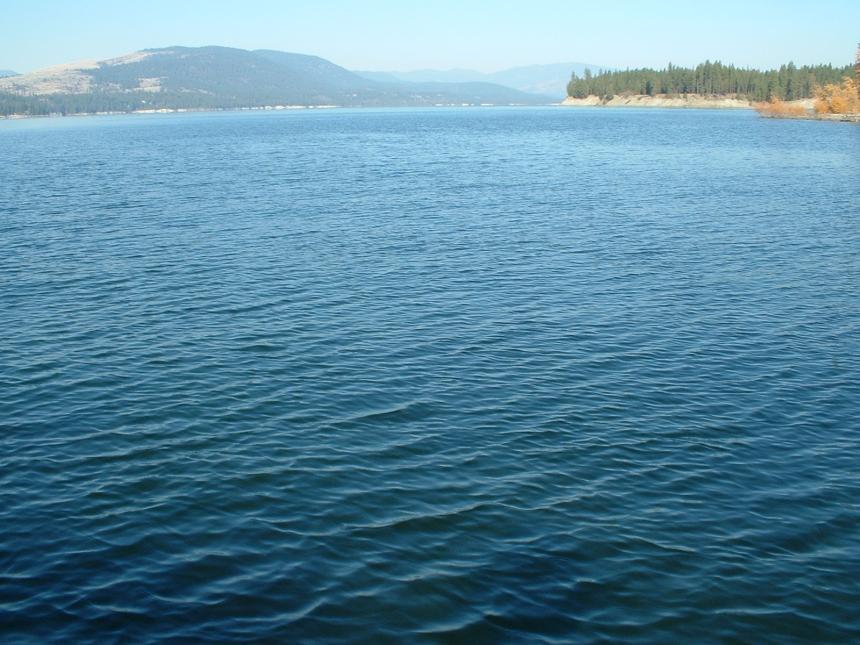This Columbia River impoundment stretches more than 150 miles from Grand Coulee Dam into Canada and is managed cooperatively between WDFW, the Colville Confederated Tribe of Indians and The Spokane Tribe of Indians. Fishing season is open year-round, except for sturgeon, which are subject to special rules and seasons. White Sturgeon, Rainbow Trout, Kokanee, Walleye and Smallmouth Bass are the star attractions. Cooperative net-pen rearing projects at numerous locations provide the Rainbow Trout fishery. The cooperative net-pen project plants approximately 750,000 triploid catchable Rainbow Trout annually into Lake Roosevelt. Check the latest regulations pamphlet for special trout and Kokanee rules. Other fish available to catch are Burbot, Lake Whitefish, and Yellow Perch.
Fishery managers in Washington state and British Columbia began sturgeon hatchery programs in the early 2000s in response to a decades-long decline in the White Sturgeon population in Lake Roosevelt. As a result, a harvest sturgeon fishery became possible in 2017. The sturgeon fishery is opened only by emergency regulation, and rules often vary by year. Current information on the sturgeon fishery can be found on the Columbia River white sturgeon page.
Lake Roosevelt is one of the waters on which we conduct our annual Fall Walleye Index Netting (FWIN) surveys. The FWIN methodology was developed in Ontario, Canada as a means of monitoring a wide variety of biological parameters in Walleye populations in a standardized fashion using gill nets. Check our publications page for FWIN survey reports.
The National Park Service operates 35 recreation areas along the 660 miles of shoreline. Maps are available at the dam's visitor center and WDFW Spokane office. Water level fluctuations can be a problem for boat launching. For current water level information, call 800-824-4916. The Washington Department of Health (DOH) has issued this fish consumption advisory for Lake Roosevelt due to mercury contamination: pregnant women, women of childbearing age, and children under six years of age should eat no more than two meals of walleye (8-ounce portion) a month. For more information, check the DOH website.
Two-pole fishing is allowed
Shoreline access: Good - Numerous access areas provide shoreline fishing access on Lake Roosevelt.
Species you might catch
- Black crappie
- Bluegill
- Brook trout
- Brown bullhead
- Brown trout
- Burbot
- Chinook salmon
- Kokanee
- Lake whitefish
- Largemouth bass
- Mountain whitefish
- Pumpkinseed Sunfish
- Rainbow trout
- Signal crayfish
- Smallmouth bass
- Tiger trout
- Walleye
- White sturgeon
- Yellow perch
Lake information
Counties:
Stevens, Ferry, Lincoln, Okanogan, Grant
Acreage: 77684.50 ac.
Elevation: 1293 ft.
Center: 47.901889, -118.172461
Open in Google Maps
Catchable fish plants
| Stock Date | Species | Number Released | Number of Fish Per Pound | Facility |
|---|---|---|---|---|
Visit the Catchable Trout Plants page for a more detailed search of trout plants in this or other bodies of water. To view or download the source data for this table visit the WDFW Fish Plants dataset on the Washington State Open Data Portal
Fishing prospects calendar
Rainbow trout
Kokanee
Largemouth bass
Smallmouth bass
Walleye
Yellow perch
Black crappie
Bluegill
Pumpkinseed Sunfish
Brown bullhead
Lake whitefish
Photos
